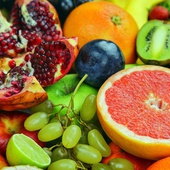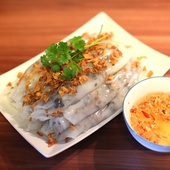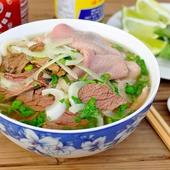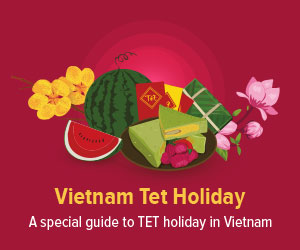Bananas
General Information
Vietnam homeland has many kinds of sweet and aromatic fruits, one of which is banana, a familiar specialty of the countryside. Speaking of bananas, no one can forget its distinctive shape, color and taste. This fruit is a domesticated fruit for a long time with a variety of types and names. The genre of bananas grown in Vietnam can range up to hundreds, mainly as follow:
Chuoi Cau: is the size of a small, round, and slightly plump fruit, resembling a betel nut. This banana tree in the right season can produce a lot of fruit. Chuoi Cau is very popular among rural people in the central and southern regions of Vietnam.
 Photo: fsf.com.vn
Photo: fsf.com.vn
Chuoi Ngu: People often think that when Chuoi Cau are not ripe, they sometimes look like Chuoi Ngu since both bananas are similar in shape, color and size. Therefore, farmers often have a mistake between these two types of bananas. To distinguish, remember that Chuoi Cau tree blooms a closer density of fruits than Chuoi Ngu. In addition, Chuoi Ngu has a very different aroma, it is very fragrant, sweet, and is extremely delicious.
 Photo: chodulich.com.vn
Photo: chodulich.com.vn
Chuoi Tieu: A bunch of Chuoi Tieu usually has just enough 10 fruits. This type of banana has a curved shape like a sickle. When unripe, the banana is dark green. When ripe, it turns into a bright yellow with a very eye-catching look. Chuoi Tieu, despite its color, green or yellow, are all edible.
 Photo: thuocdantoc.org
Photo: thuocdantoc.org
Chuoi Hot: In addition to the name Chuoi Hot (banana seed), people often call it the acrid banana due to its taste. Although the taste of this banana is not popular with many people, it has many uses. Chuoi Hot has ivory-white fillings, and as the name implies, this banana has a lot of seeds. Chuoi Hot has an acrid taste, so they are often eaten with vegetables or soaked in wine.
 Photo: thuocdantoc.vn
Photo: thuocdantoc.vn
How to eat
In other countries, people are all familiar with how to eat bananas. Usually, they peel bananas from the stem. Due to the gravity of both the banana and the part attached to the stem, this part is usually hard and firm. Hence, we tend to peel the bananas off from this section.
 Photo: duoclieuthaison.com
Photo: duoclieuthaison.com
However, in Vietnam, there is another way of peeling the bananas. From a very young age, little girls from Ha Thanh – Hanoi today - are often told by their mothers to break a banana in half before eating, because it would be more polite. Of course, for the type of bananas that are short in size like Chuoi Tay or Chuoi Ngu, then you can just peel it as it is, without having to break it apart.
Where are bananas grown in Vietnam
Bananas are easily found year-round because of their easy-to-grow and adaptable properties in many environments. For Chuoi Cau, farmers often buy these banana varieties from the lowland areas to multiply, transplant and grow in their Ha Nam garden land. Its brother – Chuoi Ngu, is also planted in the same areas. In fact, Ha Nam province is believed to be the largest source of Chuoi Ngu distribution in Vietnam. On the other hand, Chuoi Tieu is compatible with places that are humid and has regular rainfall during the year. Thus, the Red River Delta is a suitable place to grow this pepper banana variety.
Benefits of bananas
Bananas are among the world's most attractive fruits with not only delicious taste, but also thanks to its many health benefits. This fruit has various nutrients that help reduce swelling, lose weight, strengthen the nerve system and white blood cell production. Moreover, bananas also provide antioxidants, vitamin C, vitamin B6 to boost your workout performance, cure nausea when drunk and overcome the depressed mental state.
 Photo: vnhoinhap.com
Photo: vnhoinhap.com
Food made from bananas
Not the ordinary boring fruit, you can learn to make lots of interesting and delicious dishes, sweet and savory, from bananas. The creative meals that are both subtle, simple, yet taste incredibly can be named as: Che Chuoi (Vietnamese banana dessert), banana ice cream, banana cake, smoothies or savory dishes such as Vietnamese banana bean soup, stew fish with green bananas and so on.
 Photo: beptruong.edu.vn
Photo: beptruong.edu.vn
So if the Chuoi Hot banana is acrid, how do you prepare it? Do you cook it like a squash, for instance? Is it less acrid when ripe (or very ripe)? Can you slice it up and add to stir-fry? does cooking lessen the acrid taste? I found some in a local vietnamese supermarket here in San Diego and thought they were apple bananas, but they obviously are not. So how can I eat them? Thanks.

Vietnamese Fruits - An Overview
Being geographically located in the tropical zone, Vietnam is truly a heaven when it comes to fruits.

Vietnamese Cakes - A Closer Look At Vietnam's Most Varied Food
An overview to the different types of cake in Vietnam.

Vietnamese Noodles - An Overview
An introduction to Vietnamese noodles.








